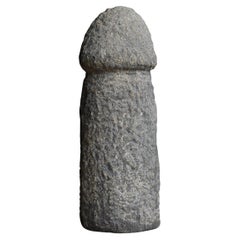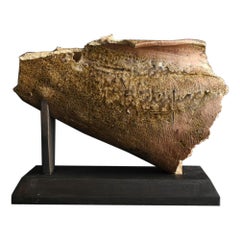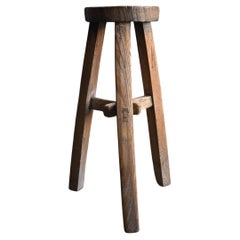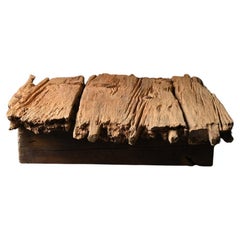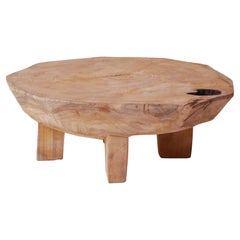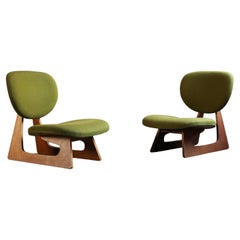Japan
to
562
1,008,774
697,978
2,232
1,570
909
516
458
379
334
173
138
113
107
95
93
80
61
49
46
46
45
42
26
23
13
12
10
9
8
7
7
6
5
5
5
5
4
3
3
2
2
2
1
1
1
1
1
1
1
289
201
64
58
46
Japanese Antique Stone Carving Penis 1800s-1860s / Sculpture Wabisabi
Located in Chōsei District Nagara, JP
This item is a stone carved penis statue made in Japan. It is a very rare relic of folk belief made in the late Edo period (1800s-1860s).
Since ancient times, there has been a cultu...
Category
Mid-19th Century Japanese Edo Antique Japan
Materials
Stone
Japanese antique pottery fragments/12th to 13th century/Flower vase
Located in Sammu-shi, Chiba
Tokoname ware is a historic kiln in Japan, where pottery has been made since before the Common Era, and a kiln was established in the 5th century. This kiln is located in Aichi Prefe...
Category
15th Century and Earlier Japanese Other Antique Japan
Materials
Pottery
Old Chinese stool / 20th century / Tasteful three-legged chair
Located in Sammu-shi, Chiba
This is an old Chinese wooden stool.
The materials used are oak and keyaki wood.
The design of Chinese stools is characterized by three legs and thr...
Category
20th Century Chinese Other Japan
Materials
Oak
Japanese Wabi Sabi Antique Wooden Low Table/1800-1920/Sofa Table
Located in Sammu-shi, Chiba
This is a low table made from a part of a rare wooden ship “Kitamae-bune” obtained in Kanazawa, Hokuriku region. Kitamae-bune was an important trading ship that connected northern an...
Category
19th Century Japanese Meiji Antique Japan
Materials
Oak, Pine
Hiroyuki Nishimura Sculptural low tray Table Amanokaguyama
By Hiroyuki Nishimura
Located in Shibuya-ku, Tokyo
Name: Amanogakuyama
Sculptural low tray table by Hiroyuki Nishimura and Zougei carved furniture
Material: Zelkova
This work is carved from log with some kinds of chainsaws.
Most of w...
Category
2010s Japanese Tribal Japan
Materials
Wood
Pair of Teiza Isu by Junzo Sakakura and Daisaku Cho
By Junzo Sakakura, Daisaku Cho, Tendo Mokko
Located in Sammu-shi, Chiba
It was designed by Daisaku Cho to compose the Japan booth at the Milan Triennale held in 1960.
At that time, he belonged to the architectural research institute of Mr. Junzo Sakakura...
Category
1970s Japanese Mid-Century Modern Vintage Japan
Materials
Teak
$10,000 / set
Antique Japanese Zushi mini shrine w/ Daikoku wood figurines wabi sabi , mingei
Located in 常陸大宮市, JP
Antique wooden Zushi (miniature shrine, the "house of the Gods") with wooden figurine of Daikoku - from Tohoku area., Japan.
Manufactured circa 1860s - 1900s (late Edo to Meiji perio...
Category
Late 19th Century Japanese Primitive Antique Japan
Materials
Wood
Japanese Antique Rustic Coffee Table 1860s-1900s / Wabi Sabi
Located in Sammu-shi, Chiba
Very old Rustic style coffee table made in Japan.
The furniture is from the Meiji period (1860s-1900s).
It is carved from a large zelkova tree.
The annual rings and grain of the zel...
Category
Early 20th Century Japanese Rustic Japan
Materials
Wood
Ross Lovegrove Bluebelle chair Y2K style design space age
By Ross Lovegrove, Driade
Located in Shibuya-ku, Tokyo
White and transparent combination chair. Ross Lovegrove designed it in 1996 for Driade.
This chair is a chair that Ross Lovegrove redesigned from George Nelson's DAF chair. Highly ...
Category
1990s Italian Modern Japan
Materials
Steel
Bubble pendant lamp Foscarini Y2K style space age 90s
By Foscarini, Karim Rashid, Valerio Bottin
Located in Shibuya-ku, Tokyo
Pendant lamp designed by Valerio Bottin around 2000. It is suitable for Y2K style pop interior. Also, Mid-century style and Space Age style.
It was produced by Foscarini. It's mad...
Category
1990s Italian Space Age Japan
Materials
Steel
Japanese antique Primitive Wooden Bench or Stool, Meiji Era'1868-1912'Wabi Sabi
Located in Hitachiomiya-shi, 08
This antique small bench was crafted in the Meiji Era (1868–1912).
The seat is made of chestnut wood, offering a sturdy texture and gentle natural grain. The legs are uniquely desig...
Category
Late 19th Century Japanese Primitive Antique Japan
Materials
Wood
Japanese Old Shell Casing 1930s-1940s / Iron Object Flower Vase Wabi Sabi
Located in Chōsei District Nagara, JP
This is the warhead part (shell) of an old Japanese shell. Functional parts such as the internal explosive and fuse have already been lost, and we present this as a safe relic that h...
Category
1930s Japanese Showa Vintage Japan
Materials
Iron
Japanese Antique Low Table / Coffee Table / 1868-1912s / Wabi-sabi Mingei
Located in Iwate-gun Shizukuishi-cho, Iwate Prefecture
This is an old Japanese low table.
It was used for reading and writing in Terakoya in the Edo and Meiji periods.
On the back, there is a trace that seems to be the letters of that ...
Category
Late 19th Century Japanese Meiji Antique Japan
Materials
Wood, Cedar
1780s-1850s Edo Japanese antique Kiri medicine chest of drawers, wabi sabi tansu
Located in 常陸大宮市, JP
Tall apothecary chest, medicine chest of drawers - "Kusuri dansu" in Japanese - is a new finds from Hyogo pref., Japan. .
Product of late Edo era (1780s-1868), estimate from the styl...
Category
Late 18th Century Japanese Edo Antique Japan
Materials
Wood
Japanese antique wooden low table covered with washi paper / Wabi-sabi workbench
Located in Sammu-shi, Chiba
This wooden low table is a wonderful item with the charm unique to Japanese antiques. It was originally used as a work board and was probably used for a long time as a tool for cutti...
Category
Late 19th Century Japanese Meiji Antique Japan
Materials
Wood
Japanese Antique Copper-Clad Door 1860s-1900s / Abstract Art Wabisabi
By Axel Vervoordt
Located in Chōsei District Nagara, JP
This is an old copper-clad sliding door (small window) made in Japan.
It was used as part of the fittings during the Meiji period (1860s-1900s), and the surface is constructed of cop...
Category
Early 20th Century Japanese Meiji Japan
Materials
Copper
Early 20th Century Japanese Cherry Blossom Screen by Kano Sanrakuki
Located in Kyoto, JP
Cherry Blossoms
Kano Sanrakuki (1898-1981)
Showa period, circa 1930
2-panel Japanese Screen
Color, gofun and gold leaf on paper
Against a backdrop of gold-leafed ground, the lichen covered trunk and branches of the life-sized cherry blossom tree reach out and beyond the confines of the pictorial surface. The overall composition has a feeling of flatness which draws emphasis to the surface and the three-dimensionality of the cherry blossoms. Painstakingly built-up layers of thickly applied shell-white gofun detail the voluminous blossoms and cover large areas of this tour-de-force of Japanese Nihonga painting. By simplifying the background, minimizing the number of colors and depicting the blossoms with such heavy relief, the artist has emphasized the stunning presence of the cherry tree. The type of tree depicted is the Yae-Zakura; a double-layered type of cherry blossom famed for its beauty and strength. When we think of Japanese cherry blossoms, the first thing that comes to mind is Somei Yoshino variety, which has a single flower with five almost white petals. This type is fragile and easily blown away by strong wind or rain. Most of the double-flowered cherry blossoms begin to bloom when the Somei-Yoshino falls, and the flowering period lasts longer than that of the Somei-Yoshino.
Kano Sanrakuki originally studied painting at the Kyoto City Arts and Crafts School under the tutelage of Yamamoto Shunkyo...
Category
Early 20th Century Japanese Showa Japan
Materials
Gold Leaf
Japanese Antique Paper-covered Pottery Vase 1860s-1900s / Vessel Wabi Sabi
Located in Chōsei District Nagara, JP
This is a paper-lined Pottery vase (jar) made in Japan.
It was made during the Meiji period (1860s-1900s) and was used to store and transport tea leaves at that time.
To protect the ...
Category
Early 20th Century Japanese Meiji Japan
Materials
Pottery, Paper
19th Century Japanese Screen, Deer in Spring, Maruyama Shijo School
Located in Kyoto, JP
A six-panel Japanese folding screen from the leading Maruyama-Shijo artist Okamoto Toyohiko (1773-1845). Simply featuring three deer and a few sprigs of foliage on a sumptuous gold-leaf background this work emphasizes naturalistic expression and a masterful use of negative space. Reduced to its most basic elements, the blank spaces inspire imagination and evoke the smells, sounds and even the weather of the scene. Whilst deer are traditionally depicted in association with autumn, here the green growth on the tops of the foliage indicates the season of spring. The work references Maruyama Okyo’s two-panel deer screen...
Category
Early 19th Century Japanese Edo Antique Japan
Materials
Gold Leaf
Rolf Sinnemark / "CUBE" TEA POT 401 / Rorstrand / 1985
By Rolf Sinnemark, Rörstrand
Located in Shibuya-Ku, JP
ROLF SINNEMARK is a Swedish designer and glass artist.
He studied industrial design at KONSTFACK in Stockholm. After working in the USA, he was with BODA (merged with KOSTA BODA) fro...
Category
1980s Swedish Scandinavian Modern Vintage Japan
Materials
Ceramic
Japanese Antique Large Ceramic Shrine 1860s-1920s / Object Wabi Sabi
Located in Chōsei District Nagara, JP
This is an old Japanese pottery shrine (zushi).
It was made during the Meiji and Taisho periods (1860s-1920s), and was mainly placed in gardens to enshrine deities.
The word “zushi” ...
Category
Early 20th Century Japanese Meiji Japan
Materials
Ceramic
19th Century Japanese Shunga Hand-Scroll, Katsukawa School
Located in Kyoto, JP
Shunga
Unknown artist
Meiji era, circa 1880
Hand-scroll mounted with 12 paintings
Ink, pigment and gofun on silk
Dimensions:
Each image measures H. 23.2 cm x W. 34.4 cm (9.15” x 13.5”)
The hand-scroll measures H. 28 cm x W. 540 cm (11” x 212”)
A set of 12 late 19th century Japanese Shunga paintings mounted as a hand-scroll. Two of the leaves bear the signature and seal ‘Setsuzan’, although we are unable to confirm the identity of the artist using this art name. 6 of the 12 images are taken almost directly from Katsukawa Shuncho’s late 18th century woodblock series, ‘Erotic Pictures...
Category
Late 19th Century Japanese Meiji Antique Japan
Materials
Silk
Mid 18th Century Japanese Screen Pair. Crows & Pines by Unkoku Toshuku.
Located in Kyoto, JP
Unkoku Toshuku (1722-1779)
Crows and Pines
A pair of six-panel Japanese Screens. Ink and gold leaf on paper.
Dimensions: Each Screen: H. 170.5 cm x W. 375 cm
Haha-cho or mynah birds, whose forms resemble crows in artwork, were commonly depicted in Japanese art. These types of paintings were originally modeled on paintings attributed to the 13th century Chinese painter Muqi (Mokkei), whose art was enormously influential in Japan. Crows only became a theme among Japanese artists from the later 1500s onward. They likely were inspired by these imported Chinese paintings of myna birds, which are not native to Japan, substituting the native species of crow instead.
The best known early examples of the depiction of Japanese crows are two Momoyama screen...
Category
Mid-18th Century Japanese Edo Antique Japan
Materials
Gold Leaf
Japanese Antique Black Drawer / Storage Tansu / 1868s / Wabi-Sabi Mingei
Located in Iwate-gun Shizukuishi-cho, Iwate Prefecture
This is an old Japanese drawer.
The material is made of cedar, and the drawer has traces of "Meiji 1st year" (1868) written in ink at that time.
Over time, black soot has turned in...
Category
1860s Japanese Meiji Antique Japan
Materials
Iron
Japanese Iron Garden Lantern – Meiji to Taisho Period, Early 20th Century
Located in Fukuoka, JP
A beautiful Japanese iron garden lantern dating to the early 20th century (Meiji–Taisho period). Traditionally used to illuminate temple paths and tea gardens, this piece is crafted ...
Category
Early 20th Century Japanese Taisho Japan
Materials
Iron
Italian Glass Top Sideboard 1950's
Located in Shibuya-ku, 13
Dating back to the 1950s, this Italian vintage glass-top sideboard commands an overwhelming presence. Crafted from rich walnut wood and topped with a striking blue-grey glass surface...
Category
1950s Italian Mid-Century Modern Vintage Japan
Materials
Glass, Walnut
Ararat Rugs Bidjar Rug with Lion Design Persian Revival Carpet Natural Dyed
By Ararat Rugs
Located in Tokyo, JP
This offset pattern is composed of leaves and lotus palmettes filling the various compartments against the imposing ground, while heraldic lions rear across the strapwork borders. On...
Category
21st Century and Contemporary Turkish Revival Japan
Materials
Wool, Natural Fiber, Organic Material
Ararat Rugs Mamluk Wagireh Rug with Jerrehian Border Design Egypt Revival Carpet
By Ararat Rugs
Located in Tokyo, JP
The design source of the rug comes from the possession of Endre Unger, which was sold at Sotheby’s in 1992. That rug with the central star was designed in the early 16th-century rug ...
Category
21st Century and Contemporary Turkish Revival Japan
Materials
Wool, Natural Fiber, Organic Material
$320 Sale Price
20% Off
Teiza Isu by Junzo Sakakura and Daisaku Cho 1960's
By Daisaku Cho, Junzo Sakakura, Tendo Mokko
Located in Sammu-shi, Chiba
It was designed by Daisaku Cho to compose the Japan booth at the Milan Triennale held in 1960.
At that time, he belonged to the architectural research institute of Mr. Junzo Sakakur...
Category
1960s Japanese Mid-Century Modern Vintage Japan
Materials
Teak
Kitchen Cabinets, Japanese Antiques, Cupboard, Wabi Sabi, Japandi
Located in Katori-Shi, 12
This cabinet subtly breathes the aesthetic sense of the Taisho period within its dignified, sharp lines.
The slender, sharp lines are softened by the support wheels and rounded legs...
Category
Early 20th Century Japanese Taisho Japan
Materials
Wood
Japanese Antique BK Tansu 1860s-1900s / Sideboard Cabinet Wabi Sabi
Located in Sammu-shi, Chiba
This is a very old black chest of drawers made in Japan.
This furniture was made in the Meiji era. (1860s-1900s).
The material is made of cedar wood.
The design is simple and rustic...
Category
Early 20th Century Japanese Meiji Japan
Materials
Cedar
Japanese Antique Wooden Coffee Table / Side Table / Wabi-sabi Primitive
Located in Iwate-gun Shizukuishi-cho, Iwate Prefecture
This is a coffee table made from an old Japanese mortar.
It is thought to be around the Meiji period and was used in the Tohoku region of Japan.
The wood is made of Zelkova, and it ...
Category
Late 19th Century Japanese Primitive Antique Japan
Materials
Wood, Hardwood
Japanese Antique BK Drawer 1860s-1900s / Storage Tansu Wabisabi
Located in Sammu-shi, Chiba
Very old Japanese small drawer storage.
The furniture is from the Meiji period (1860s-1900s).
It is made of cedar wood and pine.
The handles are made of iron.
This is almost in its o...
Category
Early 20th Century Japanese Meiji Japan
Materials
Cedar, Pine
Japanese Antique Pottery Jar 15th-16th Century/ Wabi-Sabi Vase/Shigaraki
Located in Sammu-shi, Chiba
I would like to introduce an attractive pot that gives you a sense of wabi-sabi.
It is "Shigaraki ware".
Shigaraki is a historical kiln located in Shiga Prefecture, Japan.
It is sa...
Category
15th Century and Earlier Japanese Edo Antique Japan
Materials
Pottery
Japanese Antique Drawer 1860s-1900s / Storage Tansu Wabisabi
Located in Sammu-shi, Chiba
Very old Japanese small drawer storage.
The furniture is from the Meiji period (1860s-1900s).
It is made of cedar wood.
The handles are made of iron.
The design is ultimately simple...
Category
Early 20th Century Japanese Meiji Japan
Materials
Cedar
Japanese Antique Black Tansu / Drawer Cabinet Storage / 1868-1912s Wabi-Sabi
Located in Iwate-gun Shizukuishi-cho, Iwate Prefecture
This is an old black cabinet in Japan, which is called a "tansu" in Japan.
It seems to be around the Meiji period, and the material is made of cedar.
The drawers are wide on the si...
Category
Late 19th Century Japanese Meiji Antique Japan
Materials
Iron
Japanese Antique Large Tansu / Cabinet Sideboard / 1868-1912s Wabi-sabi
Located in Iwate-gun Shizukuishi-cho, Iwate Prefecture
This is an old Japanese cabinet.
It is estimated that it was around the Meiji period, and the main parts are all made of zelkova. It is speculated that everything made of zelkova wa...
Category
Late 19th Century Japanese Meiji Antique Japan
Materials
Iron
Japanese antique wooden sofa table/Late 19th century/Wabi-sabi low table
Located in Sammu-shi, Chiba
This is a board and a wooden box that were used in Japan from the Meiji period to the early Showa period.
These two can be combined to make a low table.
The tabletop is made of eithe...
Category
Late 19th Century Japanese Meiji Antique Japan
Materials
Cedar
Mid 19th Century Framed Japanese Painting. Mice & Millet
Located in Kyoto, JP
Obata Tosho (1812-1886)
Mice & Millet
Late Edo period, mid 19th Century
Framed Japanese Painting. Ink and color on paper.
Individually framed 19th century bird and flower paintin...
Category
Mid-19th Century Japanese Edo Antique Japan
Materials
Paper
Cambodian antique stone Buddha figurine/Angkor period/Khmer art
Located in Sammu-shi, Chiba
We will introduce very old Cambodian sculpture art.
This was made as part of architectural sculptures such as temples.
It is thought to be a Baphuon...
Category
15th Century and Earlier Japanese Other Antique Japan
Materials
Sandstone
18th Century Antique Swedish Red Painted Baroque Secretary
Located in Sammu-shi, Chiba
A two-tiered wooden cabinet from the 18th century Swedish Gustavian period. The top door opens to reveal a decorative top shelf and three other shelves. The top of the bottom shelf c...
Category
19th Century Swedish Gustavian Antique Japan
Materials
Wood
Mid-18th Century Japanese Screen Pair, One Hundred Flowers, Chrysanthemums
Located in Kyoto, JP
Omori Soun (b. 1704)
Chrysanthemums - One Hundred Flowers
A Pair of Six-fold Japanese Screens. Ink, color, gofun and gold leaf on paper.
Dating ...
Category
Mid-18th Century Japanese Edo Antique Japan
Materials
Gold Leaf
19th Century Japanese Silk Painting by Kano Chikanobu, Peacock & Bamboo
Located in Kyoto, JP
Birds & Flowers of the Seasons
Pheasants & Plum in Snow
Unframed painting. Ink, pigment and gofun on silk
Kano Chikanobu 1819-1888
Signature...
Category
Mid-19th Century Asian Edo Antique Japan
Materials
Silk
Early 19th Century Japanese Screen. Cherry Blossom & Pheasants by Mori Tetsuzan
Located in Kyoto, JP
Mori Tetsuzan (1775-1841)
Pheasants and Cherry Blossoms
Two-fold Japanese screen. Ink, color, gofun, gold and silver on paper.
A two-fold Japanese bir...
Category
Early 19th Century Japanese Edo Antique Japan
Materials
Gold Leaf
Endless column of glass / 240601 by Toshio Iezumi - Contemporary sculpture
By Toshio Iezumi
Located in Paris, FR
Endless column of glass / 240601 is a glass sculpture by Japanese contemporary artist Toshio Iezumi, dimensions (not including the stainless steel base) are 180 × 10 × 10 cm (70.9 × ...
Category
2010s Contemporary Japan
Materials
Stainless Steel
D2 Japanese Antiques Board painting, sliding door, fittings, Peony & Bamboo
Located in Niiza, JP
Size: Depth *3cm Width *87cm Height *173cm 8kg
Estimated packing size: (Sandwich with 4-5mm plywood)
12 × 100 × 185cm 20kg
This is an old fittings of ita-e (wooden board painting)...
Category
19th Century Japanese Antique Japan
Materials
Cedar
Japanese Antique Tansu / Drawer Cabinet / 1875s Meiji Period / Wabi-Sabi Mingei
Located in Iwate-gun Shizukuishi-cho, Iwate Prefecture
This is an old Japanese cabinet.
It is believed that it was used in the Tohoku region of Japan, and the material is made of cedar.
On the back, there is a trace of "Meiji 8" writte...
Category
1870s Japanese Meiji Antique Japan
Materials
Iron
Ararat Rugs Western Theme Azeri Folk Life Rug, Turkish Carpet, Natural Dyed
By Ararat Rugs
Located in Tokyo, JP
Western Theme Azeri Folk Life Rug
This unique design rug is interpreted by our designers with a composition of pictorial western-style life.
Color summary: 17 colors in total, the m...
Category
21st Century and Contemporary Turkish Oushak Japan
Materials
Wool, Natural Fiber, Organic Material
Cartier 2C Double C Ring LM Tri Color Gold 52 US 6.25
By Cartier
Located in Kobe, Hyogo
Item: Authentic Cartier 2C Ring LM
Stones: ---
Metal: 18K Yellow / Rose / White Gold
Ring Size: 52 US SIZE 6.25 UK SIZE L 3/4
Internal Diameter: 16.75 mm
Measurements: 8.8 - 10.4 m...
Category
1990s French Japan
Materials
Gold, 18k Gold
Japanese Antique small Stone Buddha/Jizo Bodhisattva/ Edo /1750-1868/ Wabi sabi
Located in Sammu-shi, Chiba
If you want something special, we recommend purchasing items selected by Brood.
We sell carefully selected old Japanese items.
I've seen tens of thousands of items so far.
Based on t...
Category
Late 18th Century Japanese Edo Antique Japan
Materials
Sandstone
Circa 1925. Taisho era Japanese Nihonga Screen. Camellia & Bamboo.
Located in Kyoto, JP
Anonymous
Camellia & Bamboo
Taisho era
Two-panel Japanese Screen. Mineral pigment, gofun and ink on silk.
A small Japanese Nihonga screen capturing...
Category
Early 20th Century Japanese Taisho Japan
Materials
Silk
Japanese Antique BK Large Cabinet 1860s-1900s / Tansu Wabisabi
Located in Sammu-shi, Chiba
This account consists of 5 companies.
I specialize in selecting and carefully selecting Japanese antiques.
With 20 years of experience, I will re-propose Japanese antiques from a new...
Category
Early 20th Century Japanese Meiji Japan
Materials
Cedar
Japanese Old Garden Stone "Tsukubai/Toukeisi" Stone Water Basin
Located in Sammu-shi, Chiba
We Japanese introduce unique items with unique aesthetics, purchasing routes, and ways that no one can imitate.
This is a traditional Japanese item from ancient times.
There is a c...
Category
19th Century Japanese Edo Antique Japan
Materials
Stone
1890-1930s Japanese antique large Mizuya tansu chest, wabi sabi shelf, primitive
Located in 常陸大宮市, JP
Japanese Antique Mizuya tansu chest / side board, From Kanto area, Japan.
Made from premium quality, reddish Sugi Cedar, the product of circa 1900s to 1930 (late Meiji to early Show...
Category
Late 19th Century Japanese Taisho Antique Japan
Materials
Wood, Cedar
Japanese Antique Low Table / Sofa Table Coffee Table / 1868-1912s Wabi-Sabi
Located in Iwate-gun Shizukuishi-cho, Iwate Prefecture
This is a low table that combines old Japanese trees.
The detailed tree species of the upper board is unknown, but it is considered to be katsura wood, and the color has become dark...
Category
Late 19th Century Japanese Meiji Antique Japan
Materials
Wood, Cedar
Japanese Woven Willow Storage Chest, ''Yanagi Gori'', Early 20th Century
Located in Edogawa-ku Tokyo, JP
An exceptional example of Yanagi Gori — a traditional Japanese storage chest woven from koriyanagi (a type of supple willow).
Produced in the early 20th century, this handcrafted box...
Category
Early 20th Century Japanese Japan
Materials
Willow
Early 20th Century Japanese Screen Pair - Ink Pine Trees on Gold
Located in Kyoto, JP
Imao Keisho (1902-1993)
Pine Trees
Early 20th Century, Circa 1930
Pair of six-panel Japanese screens. Ink on silk and gold leaf.
Dimensions: Each screen H. 67.5” x 148” (172 cm x 376 cm)
A pair of monumental six-panel Japanese pine screens by the renowned Nihonga artist Imao Keisho. Here Keisho entirely removed the background and brought the pine trees to the surface of the painting. This simplification of the elements makes the scene exceptionally direct and compelling and injects a very modern...
Category
Early 20th Century Japanese Showa Japan
Materials
Gold Leaf
Japanese Antique Tenjin Desk, Meiji Era (1868-1912), Wabi Sabi
Located in Hitachiomiya-shi, 08
This antique tenjin desk was crafted in the Meiji Era (1868–1912).
Originally used in traditional terakoya (temple schools), this low writing desk was designed for a lifestyle where...
Category
Late 19th Century Japanese Meiji Antique Japan
Materials
Wood
Japanese Antique Rustic Table 1860s-1900s / Dining Table Wabi Sabi Mingei
Located in Sammu-shi, Chiba
This is a very old Japanese Rustic table.
It has a simple style with a wooden board on top of the "Usu".
The "Usu" was used for crushing nuts and kneading rice for mochi.
Generally,...
Category
Early 20th Century Japanese Meiji Japan
Materials
Wood
Japanese Antique Tansu / Drawer Cabinet / 1868-1912s / Wabi-Sabi Mingei
Located in Iwate-gun Shizukuishi-cho, Iwate Prefecture
This is an old Japanese drawer.
It has been used in stores since the Edo period in the Tohoku region, and it is estimated that it was made around the Meiji period.
The material is ...
Category
Late 19th Century Japanese Meiji Antique Japan
Materials
Iron
